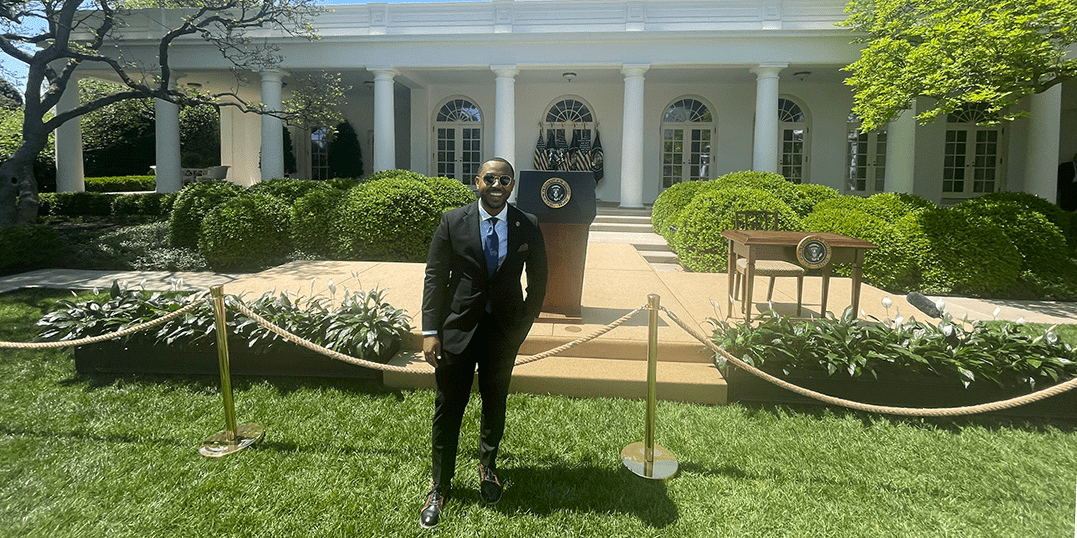Associate Professor Marccus Hendricks admits he is still processing his recent one-year appointment as a Senior Advisor of Climate and Community Resilience at the White House.
After experiencing a couple of highlights, such as working on the inaugural Environmental Justice team, serving under an administration with the first Black woman vice president or even gazing out of his office window to casually see democracy in action, you can understand why.
A sought-after national voice in his field, the urban studies and planning professor brought his extensive on-the-ground expertise to the White House to address environmental justice issues, such as flood and coastal resilience, climate adaptation and broader disaster management.
“It felt like an incredible opportunity,” Hendricks said, reflecting on his experience. “It was never on my agenda to serve in the Federal Government, but I think it was always important to me, as a scientist, to not just allow my science to sit on the shelf somewhere or to share [my] science with other scientists. It was always intentional on my part to take my science a little further, whether that was engaging with communities or, in this particular opportunity and position, translating that science into policy and influencing not only what we know, but how we act and what we do.”
In his role, Hendricks advised and assisted the Council on Environmental Quality (CEQ) at the White House to support the development of federal policies, initiatives and efforts to improve, preserve and protect America’s public health and environment, especially in areas relevant to climate resilience and natural disasters.
One of his most memorable efforts included joining President Biden and environmental justice leaders from across the country in the White House Rose Garden for the signing of Executive Order (EO) 14096 in the Rose Garden on April 21, 2023 – just three and a half months into his appointment. Hendricks served as co-chair and led the launch of the Environmental Justice Subcommittee of the National Science and Technology Council, which is included in the executive order. The subcommittee, which is first in the nation, was established to address the need for a coordinated federal strategy to identify and address gaps in science, data and research related to environmental justice.
Hendricks also assisted with the advancement of priority activities mandated for CEQ in EO 14008, including the Justice40 Initiative, which set a goal that 40% of the overall benefits of certain federal investments flow to disadvantaged communities; Climate and Economic Justice Screening Tool (CEJST), a spatial mapping tool used to identify those disadvantaged communities; and the Environmental Justice Scorecard, the initial effort to track the work the Federal Government and federal agencies are doing towards environmental justice.
Additionally, during the last week of his detail, Hendricks and his partners launched the National Climate Resilience Framework, a first-of-its-kind national approach to climate resilience consisting of input from the Executive Office of the President (EOP) and several partners across federal agencies.
Although Hendricks made significant contributions and advancements in the environmental justice space during his appointment, he believes additional consistent, intentional work is needed to build more resilient communities and “support communities to mitigate, prepare for, respond to and recover from climate-induced risks and threats” because climate change is an existential crisis of our time.
“My hope is that we get to a place one day, where there's no such thing as disadvantaged communities because people are treated fairly and and justly,” Hendricks said. “Everything that I do is anchored in or centered on that justice lens and that justice perspective, particularly Black communities and Brown communities, but then other communities of color as well.”
“I think that Black folks have a unique history in this country – that's undeniable,” he added. “I think, time and time again, even amongst other communities of color, we find ourselves being in the brunt of sort of the most marginalized and disadvantaged.”
Hendricks applied his work at MAPP to the role, since he considers the built environment to be the center of how we think about environmental justice in terms of the nation’s laws, regulations and policies.
“I think everything we do within the school was and is directly applicable to the sort of lens that I was taking to my role at the White House,” Hendricks said.
He also drew inspiration from the work he’s doing with the Water Emergency Team (WET) and Stormwater Infrastructure Resilience and Justice (SIRJ) Lab and how they relate to environmental justice efforts.
“My lab [SIRJ]…, allowed me and my students to take a social lens to built and physical issues and problems, with several projects spanning the D.C. Maryland, Virginia region,” Hendricks said. “I think all of that knowledge, information and experience through my time in the classroom, through my research efforts and through my research laboratory went hand in hand with the things that I was working on at the White House – and the policy that I was helping to shape through my time [there].”
Hendricks noted he is looking forward to sharing the “sweet spot” of connecting policy to science at MAPP. He wants to pass on his knowledge to students, and help them understand how policies translate to local, state and federal governments, and in return, students can make efforts to ensure the Federal Government is supporting their goals and initiatives.
‘I think 10, 20 years from now, I'll look back on it and really sort of have a lot more to say,” he said. “I think we won't see the fruits of the labor and the impact of those efforts until probably years from now, and just the thought of it is remarkable.”
“I hope that my contribution and my legacy are making a small drop in a bucket to rewriting that narrative and transforming these communities to where, ultimately, either I put myself – or future folks who I might be passing a baton to – out of business,” he added.

